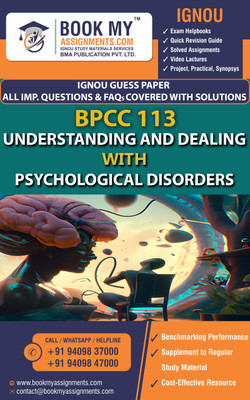IGNOU BPCC 113 Understanding and Dealing with Psychological Disorders | Guess Paper | Important Question Answer |BACHELOR'S (HONOURS) DEGREE PROGRAMMES(Paperback, BMA Publication)
Quick Overview
Product Price Comparison
Introduction to Psychological Disorders: The course would likely begin with an introduction to the concept of psychological disorders, including definitions, classifications, and prevalence rates. Students would learn about the biopsychosocial model of mental illness, which considers the interplay of biological, psychological, and social factors in the development and manifestation of disorders.Diagnostic and Statistical Manual of Mental Disorders (DSM): Students might delve into the DSM, which is the primary diagnostic classification system used by mental health professionals to classify and diagnose psychological disorders. They would learn about the criteria for diagnosing specific disorders and the process of differential diagnosis.Anxiety Disorders: The course could cover anxiety disorders, which are characterized by excessive fear, worry, and avoidance behaviors. Students would learn about specific anxiety disorders such as generalized anxiety disorder, panic disorder, phobias, and obsessive-compulsive disorder (OCD), as well as the causes, symptoms, and treatment approaches for each disorder.Mood Disorders: Students may explore mood disorders, which involve disturbances in mood or affect. They would learn about mood disorders such as major depressive disorder, bipolar disorder, and dysthymia, as well as the biological, psychological, and environmental factors that contribute to the development and course of these disorders.Psychotic Disorders: The course might cover psychotic disorders, which involve disruptions in thinking, perception, and behavior. Students would study psychotic disorders such as schizophrenia and schizoaffective disorder, exploring symptoms, etiology, treatment options, and the impact of stigma on individuals with these disorders.Trauma- and Stressor-Related Disorders: Students could delve into trauma- and stressor-related disorders, which are characterized by exposure to traumatic or stressful events. They would learn about disorders such as post-traumatic stress disorder (PTSD), acute stress disorder, and adjustment disorders, as well as the psychological and physiological effects of trauma and stress.Substance-Related and Addictive Disorders: The course may cover substance-related and addictive disorders, which involve the misuse or dependence on psychoactive substances. Students would learn about substance use disorders such as alcohol use disorder, opioid use disorder, and gambling disorder, as well as the biological, psychological, and social factors that contribute to addiction and recovery.Eating Disorders: Students might explore eating disorders, which involve disturbances in eating behavior and body image. They would study eating disorders such as anorexia nervosa, bulimia nervosa, and binge-eating disorder, as well as the cultural, psychological, and interpersonal factors that influence the development and maintenance of these disorders.Personality Disorders: The course could cover personality disorders, which involve enduring patterns of behavior, cognition, and inner experience that deviate from cultural expectations and cause distress or impairment. Students would learn about personality disorders such as borderline personality disorder, narcissistic personality disorder, and antisocial personality disorder, as well as the challenges of diagnosis and treatment.Neurodevelopmental Disorders: Students may delve into neurodevelopmental disorders, which typically emerge in childhood and involve impairments in cognitive, social, and adaptive functioning. They would learn about neurodevelopmental disorders such as autism spectrum disorder, attention-deficit/hyperactivity disorder (ADHD), and intellectual disability, as well as the role of genetics, brain development, and early intervention in these disorders.


